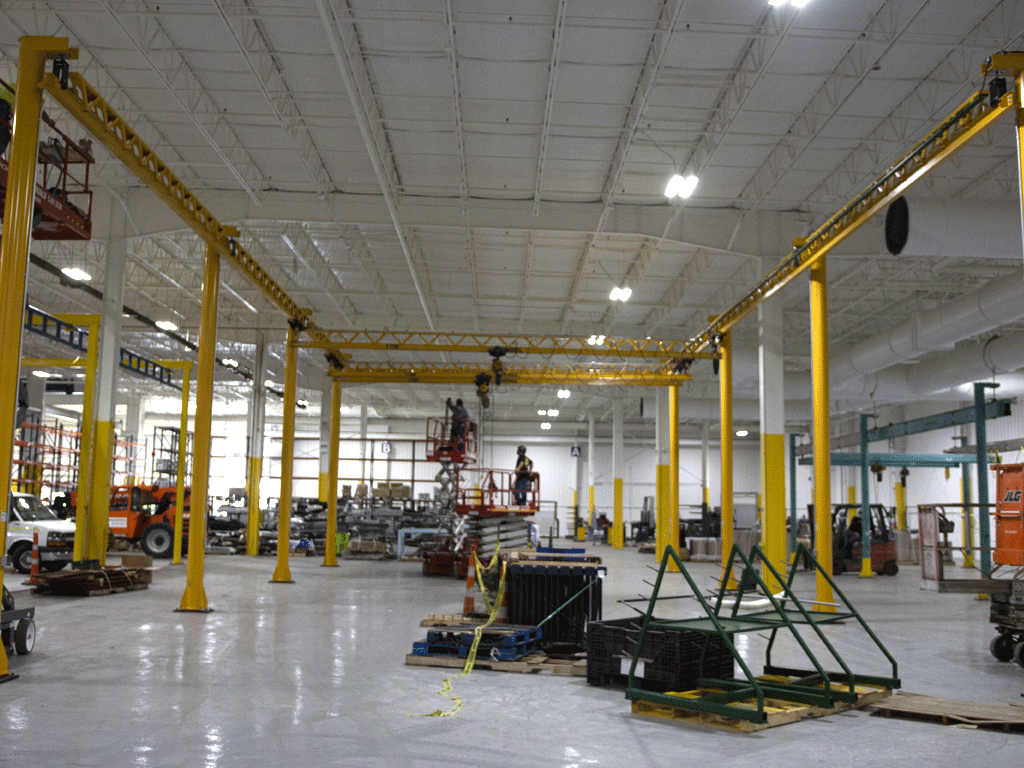Introduction:
Cranes cross a bridge between two parallel runways to support the factory structures themselves. On the bridge, beams are the hoist and trolley. You shift the loads up and down over the beam, to the right, and the left. The crane drives the load forward and backward through the finishing trucks on the runway grid. The crane, therefore, provides three axes of hook movement and can shift the load in a rectangular field without any restrictions. We do our best to have high-quality cranes, much like other renowned cranes manufacturers. Our cranes are in top running and operating configurations, single and double girders.
Advantages of overhead cranes:
- The overhead crane can deliver three hook motion axes and cover a wide rectangular space. By extending the length of end vehicles, the area will expand.
- It has a small floor space installed in the upper part of the factory. It reduces the risk of chariots and barriers. In exchange, this increases protection and performance.
- It is usually suited to heavy-duty environments such as steel, paper, power generation, and refineries.
- overhead crane needs less maintenance than other kind of lifting equipment with its favorable construction. It’s more accessible.
Who carries out agricultural equipment maintenance?
Mostly, farmers are the ones who maintain their machinery themselves, which ensures that they need a wide variety of information about their devices. In small family farms, a single individual (with the help of family members often) will maintain much of the business, whereas major activities are carried out with many hands-on the boat.
There is a lot of unqualified jobs in agriculture and as such farmers often have no formal training in managing their farm properties. As a result of inadequate maintenance procedures, incidents and injuries may occur.
Why can overhead cranes be used with machinery?
To inspect, measure, validate and certify all forms of cranes, hoists, and elevators, SGS is the world’s leading firm. They help to supply you with the unmatched skills, training, and equipment to inspect cranes for:
- Material processing devices: cranes, derricks, forcings, cranes for trucks, hooks, raising ramps, telehandler, and other equipment
- Management equipment: elevators, escalators, lifts, cable cars, and mobile lifting platforms (MEWPs)
Inspection of cranes, hoists, and lifts will support you: You can:
- Comply with all the relevant legal criteria, independence of inspection undertaken under all applicable guidelines, legislation, and engineering practices
- Ensure that the crane or lifting and hoist equipment works safely and properly
- Keep your equipment capable and available
- Maximize the organizational effect of the uptime and expected outages
As a leading provider of cranes nationally, We build and ship to all 50 states. Our cranes meet or exceed OSHA standards for:
- Cranes, hoists, and lifts include:
- Brakes, clutches, sheaves, and rope assemblies control
- Calculation and design research
- Checking the dynamic and static load
- inspection of all load-bearing structural components and sheaves
- Operational checks to make sure the unit functions correctly
- Periodic testing before use of mechanical, structural, electrical, and protective systems and wire cables and chains inspections
- Both protective systems re-examined
- Evaluations of regulatory enforcement
- Life evaluation remaining
- Oversight on repairs
How critical is the protection of lifting equipment?
It can be risky to operate for any moveable machine can cause accidents in many ways:
- it may be struck, wounded, or dropped, or expelled by moving machine pieces. Body parts may also be pulled between rollers, belts, strings, and pulleys or stuck between them.
- Cuts and serious injury can result in sharp corners, sharply-pointed sections may mark or punch the skin, and rough surfaces can contribute to friction or abrasion.
- People may be crushed either in pieces moving together or against a set section of the mechanism, the wall, or some other component.
- Computer components, materials, and emissions (such as steam or water) could be hot or cold, or electricity could induce burns or scalding.
- Devices or attachments could become defective and cause problems due to inadequate or non-maintenance, or computers could be misused due to lack of expertise or instruction.
How to perform agriculture equipment maintenance safely?
It is important for companies to maintain regularly, ensuring it is done safely is just as important. Mechanical repair and the frequency rating next to fieldwork and animal treatment is one of the primary causes of injuries on the farm.
The following indicators will ensure that maintenance is done as efficiently as possible on your equipment.
Learn the owner’s manual:
It is strongly advised that you read the owner’s manuals for your computers to repair machinery safely. This not only gives you details about which components are needed and how much regular service procedures can be performed but also tells you about risks involved with work on the equipment.
Shut down and protect machinery before repairs:
Make sure it is powered down properly first before operating the system. Not only should all switches be “off,” but any system control also should be disconnected (wherever applicable). This prevents the computer from switching unexpectedly on when being scheduled for maintenance, reducing the chance of an accident.
Appropriate use of the PPE:
Personal protective equipment (or PEPs) is important for proper maintenance. When working on a majority of mechanical and structural repairs, gloves and hard hats shall be recommended and specialized tools should be used when employed in height or enclosed spaces with smoke (respirators).
Use the right instruments:
Poorly built or insufficient instruments pose an ergonomic danger to farm equipment staff. In certain circumstances, due to financial limitations, the best tool for the job may not be affordable, or just not easily accessible, forcing farmers and farmers to replace something else.

